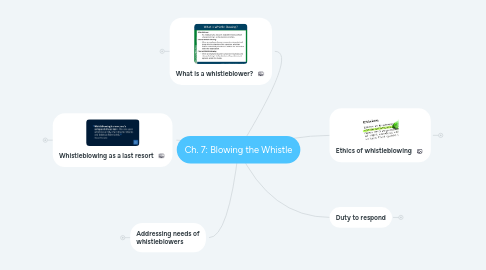
1. What is a whistleblower?
1.1. Internal
1.1.1. going to someone inside the organization
1.2. External
1.2.1. going to someone outside the organization
1.2.1.1. _
1.2.1.2. -
2. Ethics of whistleblowing
2.1. When is it ethical? 5 conditions:
2.1.1. when it will cause serious harm to the public or break existing laws
2.1.2. when employee identifies a serious threat of harm
2.1.3. when immediate supervisor fails to act
2.1.4. the employee has documentation that company is putting the public or product user in danger
2.1.5. the employee must believe that reporting wrongdoing will fix the situation
2.2. When is it unethical?
2.2.1. if the whistleblower is motivated by opportunity for
2.2.1.1. financial gain
2.2.1.2. media attention
2.2.1.3. revenge
2.2.2. Qui tam lawsuits:
2.2.2.1. whistleblowers are entitled to between 10-30% of amount recovered
2.3. Year of the whistleblower - 2002:
2.3.1. Sharon Watkins
2.3.1.1. https://youtu.be/Mi2O1bH8pvw
2.3.2. Coleen Rowley
2.3.2.1. https://youtu.be/9_CFh-Ov5Eg
2.3.3. Cynthia Cooper
2.3.3.1. https://youtu.be/7g_d-phoUrU
3. Duty to respond
3.1. Whistle-blower Protection Act (1989)
3.1.1. applied to Federal government employees
3.2. Sarbanes-Oxley (2002)
3.2.1. encouraged whistleblowing
3.2.2. prohibited retaliation against whistleblowers
3.3. Dodd-Frank (2010)
3.3.1. whistle-blowers concerning SEC or CFTC wrongdoing can get 10-30% of money collected if in excess of $1 million
4. Addressing needs of whistleblowers
4.1. 4 mechanisms organizations should have in place:
4.1.1. well-defined process to document how complaints are handled
4.1.2. employee hotline to file complaints confidentially
4.1.3. prompt & thorough investigation
4.1.4. detailed report of investigations
